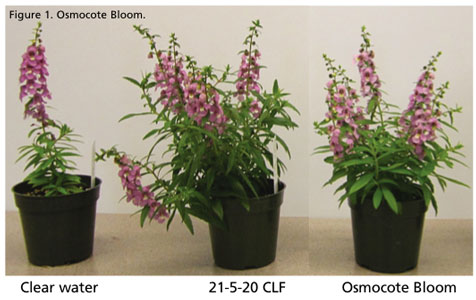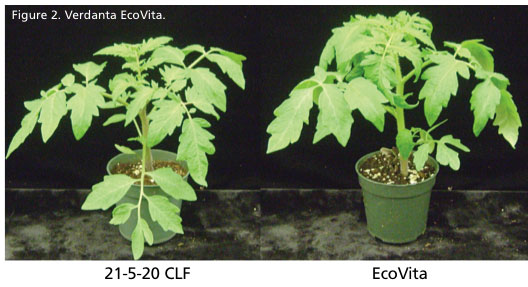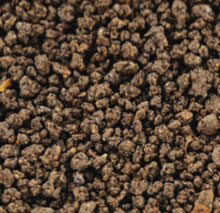1/31/2017
Fertilizer 2.0
Dr. Neil Mattson
As greenhouse growers, our philosophy on fertilizer management has changed over time. Gone are the days when we could fertilize at high rates without thinking about costs or environmental impacts. At the same time, there’s greater realization how various nutrient elements impact plant health and new products are being formulated to solve specific nutritional problems. In addition, recent advances in fertilizer technology are creating products that are easier to use, reduce nutrient leaching and are more cost-effective. Below are some examples.
Substrate incorporated  fertilizers for bedding plants
fertilizers for bedding plants
Controlled release fertilizers (CRFs) can be difficult for bedding plants due to their short production period and small container volume, which can cause uneven mixing. Osmocote Bloom 12-7-8 (ICL Group) has a small prill size for even mixing and a two- to three-month release period for short-term crops. In Cornell University trials, Osmocote Bloom has performed well

in 4-in. (500-mL) pots for growing a range of bedding plants (wax begonias, coleus and pansy) as compared to liquid-fed control plants (Figure 1). Osmocote Bloom was incorporated into the substrate at 3.5 lbs. per cubic yard (medium label rate) prior to transplant. Liquid fed plants received 150 ppm nitrogen from 21-5-20 during weekdays and clear water on weekends.
For certified organic growers or conventional growers wanting to use sustainable slow-release fertilizers, checkout out the Verdanta line of products from BioWorks, Inc. The granular fertilizers are formulated using MINIGRAN technology—that is, small-size granules that are uniform in composition to allow for uniform mixing in substrates for small container sizes. EcoVita 7-5-10 has performed well for low- to moderate-feeding vegetable transplants, herbs and bedding plants in Cornell trials (Figure 2). New to the product line is the higher nitrogen, N-Vita 9-4-3, which is also certified organic granular MINIGRAN product (Figure 3).

Substrate-incorporated fertilizers can reduce the labor cost of mixing and applying fertilizers as compared with fertigated plants. Just be sure to use the substrate within a week or two of mixing to avoid buildup of salts, as the products will begin to release fertilizer in storage.
Liquid organics
While liquid organic fertilizers are nothing new, they’ve traditionally been low in N-P-K, requiring higher usage rates and incurring high shipping costs. Higher analysis of amino acid concentrates and hydrolyzed protein powders (typically 10% to 15% N) have also been available, but rarely offer more than supplemental nitrogen. Enter two new products from Suståne that are high in nutrient value: powdered fertilizers—designed to be mixed with water and liquid applied.
Suståne Complete WDF (8-2-4) is formulated as a complete organic fertilizer, delivering a well-balanced mix of macro- and micro-nutrients, as well as kelp extract. Suståne Hi-N WDF (12-0-1) is designed to be used as a supplemental source of nitrogen, alone or in combination with compost teas. When used for fertigation, such products should be prepared and then pre-filtered to avoid clogging of irrigation lines and drip emitters. Subsequent flushing and rinsing of lines with water will also help slow build of up biofilms that can reduce flow rates.
A new tool for pH Management
Traditionally, when growers need to decrease root-zone pH, they select a more acidic fertilizer or inject acid into their irrigation water. One new tool for pH control are the Peters Excel pHLow fertilizer formulations (19-11-21, 15-75-25 Mag, 18-18-18 and 14-8-14 Cal Mag, ICL Group). These formulations contain a special phosphorus acidifying chemistry that reduces alkalinity in irrigation water. The amount of alkalinity reduction depends on the fertilizer rate used. When applied at 200 ppm N, alkalinity is reduced by about 40 ppm CaCO3. Likewise, applied at 100 ppm N, alkalinity is reduced by about 20 ppm CaCO3. Therefore, this fertilizer tool may work best for those with moderate alkalinity or on the borderline of needing acid injection.
And for even more pH-lowering impact, the newest product in the pHLow family is Acid Hammer 21-7-7, which contains the same acidifying chemistry of the pHLow products, along with a high charge of ammoniacal-N fertilizer to further decrease media pH. Acid Hammer 21-7-7 applied at 100 ppm N reduces alkalinity by 106 ppm CaCO3. Acid Hammer 21-7-7 could be used periodically when substrate pH is high or more frequently for acid-loving plants.
Silicon to enhance stress tolerance
While silicon (Si) isn’t considered an essential plant nutrient, the stress tolerance of some plants is improved when they have access to supplemental Si. Reported benefits of incorporating silicon into a nutrition program have included improved salt tolerance, plant strength, disease resistance and postharvest- keeping quality for some crops. While soils often have plenty of silicon, there’s little plant-available silicon in standard potting mixes, therefore, we’ve been conducting experiments with liquid potassium silicate (Pro-TeKt 0-0-3 +7.8% Si from Dyna-Gro).
A difficulty is that the Si products currently available will cause precipitation if mixed at concentrated levels in the same stock tank as other water-soluble fertilizers. So we either drench separately with 100 ppm silicon once a week or use a second fertilizer injector and stock tank to supplement the standard fertilizer program continuously with 50 ppm silicon.
For poinsettias Prestige Red and Pesterstar Red, we found that plants grown with 50 ppm silicon were less susceptible to breakage. In postharvest life studies, where poinsettia plants were held in a simulated retail environment and left unwatered, they lasted two to three days longer before wilting.
In other experiments, we’ve found that Si supplementation improves heat tolerance of petunia plants and salt tolerance of other bedding plants (including New Guinea impatiens). A couple of caveats: Unless a stress is present, we often don’t see substantial silicon benefits and silicon isn’t a miracle for every plant and every ailment.
A micronutrient boost
With a more conservative approach to application rates for liquid feed, growers can achieve more toned/compact plants and reduced need for plant growth regulators. However, because traditional fertilizers relied on higher application rates to supply sufficient micronutrients, deficiencies of micronutrients (especially iron) have become more common.
The Jack’s FeED line of water-soluble fertilizers from JR Peters, Inc. were designed to supply greater levels of iron and from three chelate sources (EDDHA, EDTA, DTPA) to ensure iron is plant-available at a higher pH. Be on the lookout for a new micronutrient package from JR Peters, with all chelated micronutrients, also including their triple-chelated iron. The product will allow growers to add a micronutrient boost to their standard fertilizer program and have the benefit of greater micronutrient available at high media pH.
What’s next?
Looking into the crystal ball, fertilizer technology will continue to evolve. A focus will continue to be making life easier for the grower, formulations that proactively prevent nutrient disorders (such as by promoting nutrient availability across a broader pH range) or new chemistries that will make corrective actions more effective and safer to the plant.
Further, with our increasing environmental consciousness, we’ll see growth of fertilizers and related technologies (think substrates, wetting agents and irrigation methods) that reduce nutrient leaching. Similar to silicon, I suspect that scientists will find other beneficial nutrients that improve plant health. And I’m betting we’ll see even more fertilizers based on plant or animal by-products as renewable alternatives to traditionally mined or fossil fuel-based fertilizers.
GT
Disclaimer: Mention of trademarks or brand names is for informational purposes only and does not imply its approval to the exclusion of other products that may be suitable.
Dr. Neil Mattson, nsm47@cornell.edu, is Associate Professor and Greenhouse Extension Specialist at Cornell University. Neil is director of Cornell’s Controlled Environment Agriculture group.